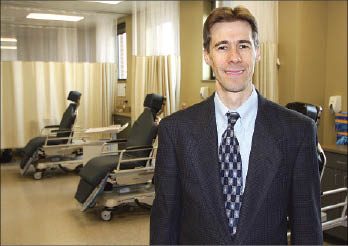
Home » Spokane Eye Clinic sees growth in future of sight care
Spokane Eye Clinic sees growth in future of sight care
Bigger facilities will help meet vision-health needs of rising older population

October 29, 2009
Spokane Eye Clinic, a longtime medical practice here, says it sees a big future in eye and vision care.
The 18-physician practice recently moved its flagship clinic into a new $9.6 million facility at 427 S. Bernard in the medical district south of downtown. The facility has twice the total floor space of the practice's original office building and its former surgery center, which both were on the same block as the new building, says Dr. Alan Johnson, an optometric physician and partner in the practice.
The new four-story clinic has a total of 44,000 square feet of clinical and office space on two floors atop two floors of parking. The larger space gives the practice enough room to take advantage of technological advances, as well as space to add physicians, to serve more patients, and to start up a research program, Johnson says.
"We've always kept up with technology," says Johnson, who's been with the practice for 12 years. "We just ran out of space. In the old building, we had equipment in hallways, which was kind of embarrassing."
Aging baby boomers are driving the need for additional space, he says.
Seniors comprise nearly half of Spokane Eye Clinic's patients, and that percentage is expected to rise, Johnson says. The U.S. Administration on Aging estimates that by 2030, 20 percent of the U.S. population will be older than 65, up from 12.4 percent in 2006.
The lower floor of the clinic is dedicated to diagnostics, testing, medical treatments, and optical services. The second floor houses a surgery center, a laser center, an optical lab, and support services.
The lower floor has 32 exam rooms grouped into eight four-room pods, Johnson says. That configuration allows up to eight physicians to schedule routine patient appointments simultaneously, while additional physicians work in the building's surgical and optical centers.
The old building had 20 exam rooms and a capacity of five physicians working simultaneously in its exam area.
One of the new pods meets federal requirements to be used in clinical research projects, Johnson says.
"We recognized the need for large-scale research in this region," he says.
Research will include study trials for medicines and procedures, Johnson says, adding that the practice plans to hire a research coordinator to work with the U.S. Food and Drug Administration and other study sites across the country that are doing research.
Of the practice's 18 physicians, 12 are ophthalmologists and six are optometrists. An optometrist is trained in examining eyes and treating certain types of visual disorders, while an ophthalmologist also is trained in general medicine and surgery.
Spokane Eye Clinic plans to recruit more ophthalmologists and optometrists over time, but Johnson declines to estimate how many, because that will depend on what subspecialties will be needed as the practice grows.
Earlier this month, an ophthalmologist who specializes in corneal transplants, lens implants, and cataract surgery joined the practice.
Due to the move, the practice has added about 30 employees to its support staff, which now is at about 150, Johnson says. He says the current priority for the practice is to finish setting up equipment and offices in the new building,
The surgery center has five operating rooms, up from three in the former location. Also, its surgery preparation and recovery area has spaces for 12 patients and is twice as large as the old space, Johnson says. Each space is outfitted with a mobile reclining chair shaped somewhat like a dentist chair. The chairs are designed to be wheeled into operating rooms, and patients stay in them from pre-op to post-op, Johnson says.
The laser center has five procedure rooms and a variety of equipment for retinal, glaucoma, and cataract treatments, as well as laser-assisted in-situ keratomileusis (LASIK) surgery, Johnson says. LASIK is performed by ophthalmologists to correct some forms of nearsightedness, farsightedness, and blurry vision. Patients who undergo the LASIK surgery sometimes don't need to wear glasses or contacts afterward.
Two minor-procedure rooms ease the surgery-center load and reduce patient costs, compared with procedures conducted in the surgery center, Johnson says. Minor procedures include some suturing, injections, and cyst removals.
Spokane Optical Co., a division of Spokane Eye Clinic, occupies space on the lower floor where it sells glasses and contact lenses and also operates Spokane Optical's lab, which manufactures about 40 sets of eyeglass lenses daily on the upper floor. Johnson says the on-site lab allows the clinic to oversee quality control, and the lab generally can fill orders quickly.
As the population ages, the demand for eyeglasses continues to rise despite advances in other corrective options such as contact lenses and surgical procedures, Johnson says.
Spokane Eye Clinic was founded by Dr. Robert Maher Sr. and Dr. Charles Gates in 1955. It formerly occupied 15,000 square feet of space in its original building, and had a 6,300-square-foot surgery center, at 208 W. Fifth, just south of the new building.
Spokane Eye Clinic's old building was razed following the move, and a surface parking lot is under construction there. The former surgery center now is vacant, and Spokane Eye Clinic hopes to find a complementary tenant to lease it, says Kim Miller, the clinic's communications director.
Ramey Construction Co., of Spokane, is the contractor on the overall project. OMS Inc., of Spokane, and Medical Design International, of Atlanta, designed it.
Spokane Eye Clinic also has branches at 31 E. Central on Spokane's North Side and at 12525 E. Mission in Spokane Valley.
Latest News
Related Articles





